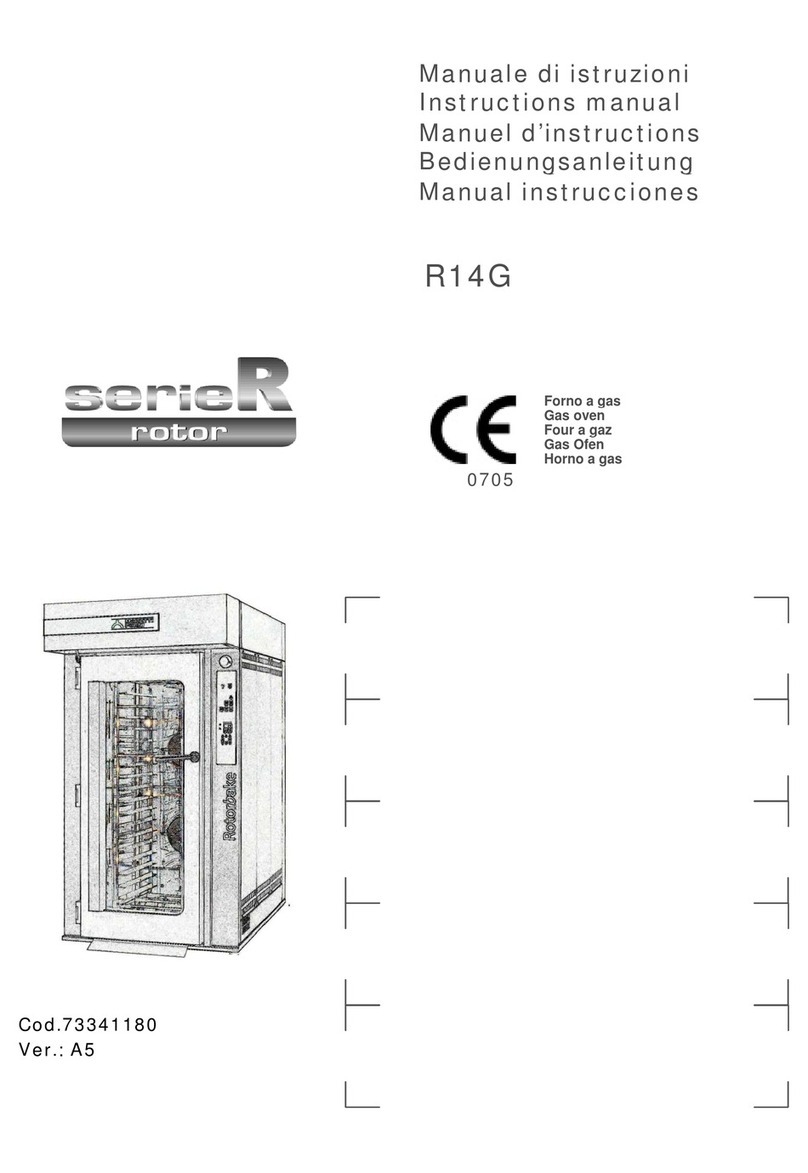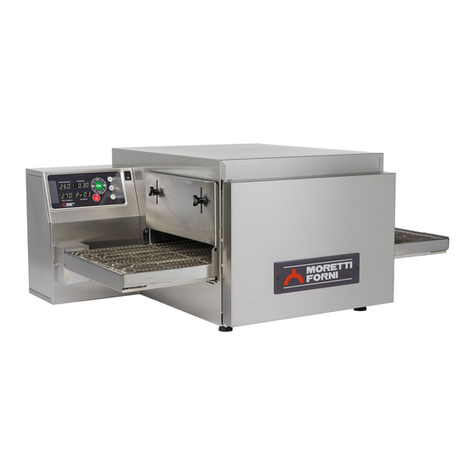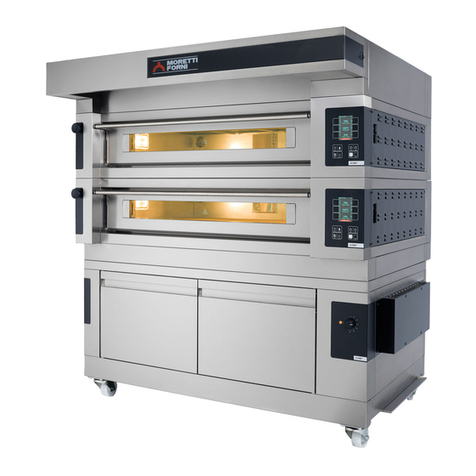
UK6
By pressing the Timer button for the third time it is possible to
return to the desired program.
5) Hold down the “P” button (fig. 12 item 14) for at least 2 seconds,
until a BEEP sound is heard; this will store the new program,
baking timer included, in the memory.
NOTE: When a general program is started, if a “Baking
time” is associated to this program, to start the timer, proceed as
for the “Manual” mode described in point 3.7.4.
USING A PROGRAM
1) Press the “P” button (fig. 12 item 14) several times until the
required baking program is displayed.
2) Turn on the chamber power supply by using the power button
(figure 12 item 9): a red LED lights up.in the upper right corner.
NOTA:The left display no longer shows the program number
but the actual temperature of the oven, which flashes until it
reaches the set point temperature set. ( 4 "Beeps" indicate that the
set point temperature was reached).
The green LED beside the “P” button will remain lit to show that one
of the programs is being used.
To see the number of the program in use while it is running, press the
“P” button. Press “Start” to return to the normal display.
3.2.4 PRE-SET PROGRAMS:
P01 RISE IN TEMPERATURE / LOW WORK LOAD
Program P01 is the program pre-configured by the Factory to
optimize the temperature rise of the oven at a pre-set operating
temperature for Pizza Napoletana. Enable program P01 as described
in 3.2.3. At the beginning of the program, the displays of the power
values show the letter "H" to indicate that the oven is in the heating
stage ("Heating") and the power values cannot be changed. Only
when a temperature set by the Factory is reached, the letters "H" are
replaced by the power values set by the program.
P02 MEDIUM WORK LOAD
P02 program is the factory-configured program for medium work
loads at a pre-set operating temperature suitable for Pizza
Napoletana. Enable program P02 as described in 3.2.3.
FROM P03 TO P20 - GENERIC PROGRAMS
Programs from P03 to P20 are factory pre-configured programs for
operating temperatures lower than the one for Pizza Napoletana.
Enable the desired program as described in 3.2.3.
NOTE: All programs can be modified as described in 3.2.3.
Program P01 is the only program optimized for temperature rise,
whose powers at the beginning of the program cannot be set (the
display Figure 12 items 6 and 8 show “H”)
3.3 STARTING UP THE EXTRACTOR HOOD
The hood has a powerful motor to extract the cooking vapours. The
main circuit breaker of the extractor is located on the front of the
control panel (figure 13B item 4).
a) Enable the switch to start the extraction.
b) To switch off the extractor, move the switch (fig. 13B item 4) in
the zero position.
3.4 DISCHARGING VAPOUR
The vapours that form inside the baking chamber exit from the door
and are collected by the front hood, which conveys them to the vapour
exhaust connection. The valve that allows to correctly adjust the
draught (figure 14) is located under the front hood. This valve is held in
position through the knob A, if held in O position, the valve will be all
OPEN and therefore the draught will have the maximum value, if held
in C position the valve will be all CLOSED and therefore the draught
will have the minimum value, the intermediate positions accordingly
will proportionally adjust the draught.
Normally, the valve must be all open, but in the presence of a chimney
with a lot of draught, it must be adjusted by closing it up to find the
ideal balance, this in order not to take away too much heat from the
baking chamber.
WARNING! The valve and the knob A are heated during
the work, so the adjustment must be carried out when the oven is
cold, if in exceptional cases, the oven valve should be adjusted, this
operation must be carried out by wearing special gloves for high
temperatures in order to avoid burns.
3.5 DESCRIPTION OF THE OVEN
- Turn off the lights and securely close the DOOR
- Set the oven approximately between 430°C and 485°C with the
Ceiling set to 8 and Floor about to 3 and turn on the oven.
- Once the set temperature is reached, remove the door by holding it
exclusively by the provided handle (figure 7 item C) and place it in the
appropriate holder (figure 7 item D)
WARNING! DOOR AND DOOR HOLDER REACH
HIGH TEMPERATURES, THEREFORE PAY GREAT
ATTENTION NOT TO TOUCH THEM IN ORDER NOT TO
GET BURNED; STORE THEM IN A SAFE PLACE THAT
CANNOT BE REACHED BY THIRD PARTIES (E. G.
CHILDREN, ETC.) AND NEVER NEAR COMBUSTIBLE
MATERIALS.
The oven is manufactured to be used with a baking system similar to
that of the wood-burning oven, so the warmest area of the baking
chamber is the rear one, in the central area the heat reaches medium
values, while the front area, where ambient air goes in, is the least hot
area; for example, initially use the central area and then the rear area
for pizza baking while the front area must be used for what are called
"mouth baking" such as "calzoni", etc..
- Begin baking and when the amount of work reaches a MEDIUM
level, set the Floor to 5/6
- When the load work increases, increase the settings of the Ceiling and
Floor, if it is necessary set them to 9 and to 9 respectively (if the
ECONOMY/POWER is pressed and held down for a few seconds the
oven reaches the maximum temperature as the Ceiling and Floor were
set to 9 and to 9 respectively
After the first baking, check if the temperature is suitable for the dough
to be baked, such a dough must have the right level of hydration and
leavening in order to be properly baked (if the hydration is poor or if
too much flour is put on the shovel, the lower part of pizza will burn
more easily); decrease or increase the temperature accordingly (if you
wish to quickly raise the temperature and minimize electrical
consumption, securely close the door of the oven until the new set
point is reached.
NOTE: The oven has electrical heating elements (resistors)
built-in the ceiling and floor refractory which reach very high
temperatures. IT IS STRICTLY FORBIDDEN TO WET THE
BAKING SURFACE EVEN WITH A DAMP CLOTH, BECAUSE
THE THERMAL SHOCK IRREPARABLY DAMAGES THE
BISCUIT-WARE; if it is necessary to clean the surface, USE
EXCLUSIVELY THE FILTER PRESS CAKES For cleaning
during the work stages, use a soft brush of adequate height. Be
careful not to hit the side/rear refractories, any impact could break
them; if this happens, the functionality of the oven is not
compromised; any cracks in Biscuit-wares may occur but they do
not compromise the functionality of the oven.
- In the event of long work breaks it is recommended to securely
CLOSE the door of the oven and to press the Economy button and turn
off the lights; the oven consumption will be reduced to the minimum
value and it will be immediately ready to bake again. At the end of the
work, turn off the oven, leave it without the door for about 15 minutes
to allow the residual internal humidity to drain off and then place back
the door WELL CLOSED.
WARNING! In the event that unintentionally the products
during the baking stage catch fire (for example because they
contain oils or fats), close the door and seal it to smother the
flames, do not use water inside the baking chamber.
NOTE: The door, when needed, MUST BE PERFECTLY
CLOSED, TO DO SO POSITION IT ON THE CAST IRON PART
OF THE OVEN MOUTH (figure 7 item C), THE DOOR MUST
NEVER BE LEFT PARTIALLY OPEN TO PREVENT
OVERHEATING AND CRAKCS ON THE GRANITE FRONT
SURFACE Be careful not to hit / scratch the granite surface with
trolleys, shovels, etc. in order not to damage it.
3.6 STARTING UP THE LEAVENING COMPARTMENT
The control panel of the leavening compartment is the one located on
the left, below the front sliding door of the baking chamber, as shown
in figure 13A (if the hood extractor is present, refer to figure 13B).
1. Indicator light (ON/OFF).
2. On/off circuit breaker for internal lighting (to be enabled the
thermostat must be activated).
3. On/off and regulation thermostat.
a) Turn the leavening compartment on by turning the thermostat
(item 3), the indicator light will come on (item 2).
b) Set the temperature required, up to a maximum 65°C (150°F).
































